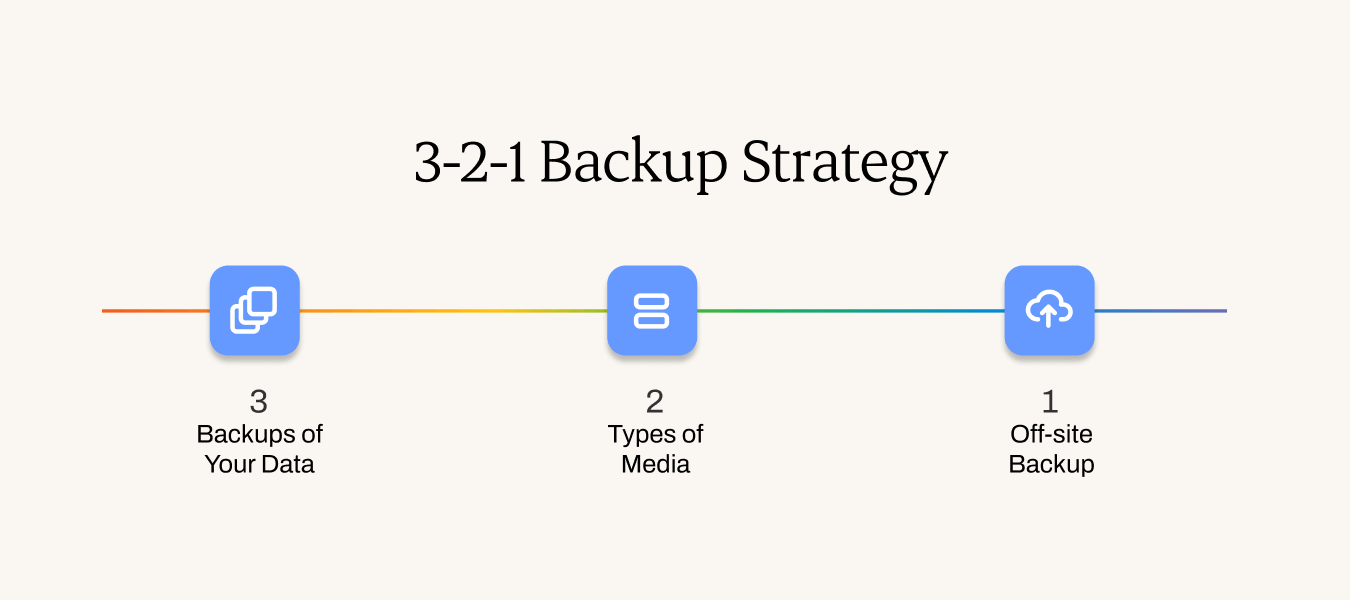5 Reasons Why a Photography Backup Plan is Vital
In today's digital age, we rely heavily on capturing and storing precious memories through photographs.
That’s why a photography backup plan is all-important! Whether you’re a hobbyist or a professional photographer, you need to have a solid backup plan.
Good backups are especially essential when someone is hiring you to record their precious memories.
At the same time, even if you’re “just” a hobbyist, those precious memories are even more important since they’re your memories.
Whether it's a family vacation, a wedding, or a significant milestone, images hold immense sentimental value, and losing these cherished images is a distressing prospect.
In this article, we will delve into why backing up your images is vital and explore an effective photography backup plan to ensure the preservation of your and your clients' irreplaceable memories.
Why you need a photography backup plan

1. Protection against accidental loss
Accidents happen, and they can occur at any time.
A simple device malfunction, accidental deletion, or loss can result in the permanent erasure of your precious images.
By regularly backing up your images, you safeguard against these unforeseen circumstances, ensuring that your or your clients' memories are not lost forever.
2. Defending against hardware failures
Technology is not flawless, and hardware failures can occur without warning.
Hard drives can crash, memory cards can become corrupted, and smartphones can get damaged or lost.
Without proper backups, all the images stored on these devices become vulnerable.
By creating backups on separate storage mediums, such as external hard drives, cloud storage, or even DVDs, you ensure your images remain intact, even in the face of hardware failures.
3. Guarding against theft & disasters
In unfortunate instances of theft, fire, flooding, or natural disasters, physical devices storing your images can be destroyed or stolen.
With backups, you avoid losing not only tangible memories but also digital copies.
Storing your images on off-site cloud storage or external drives that are stored in a secure place, such as a safe, can help protect against such unforeseen events, giving you peace of mind knowing that your memories are secure.
4. Preservation across time
Photographs are timeless artifacts that capture moments frozen in time. They allow us to reminisce and share our memories with future generations.
However, digital formats and storage technologies can become obsolete over time.
By backing up your images in multiple formats and regularly updating them to adapt to new technologies, you ensure the longevity of your cherished memories, making them accessible for years to come.
5. Organization & easy access
Backing up your images also brings the benefit of organization and easy access.
By employing proper photography backup plans, such as categorizing and labeling your files, you can easily locate specific images when needed.
Additionally, with cloud storage and online backup solutions, you can access your images from any device with an internet connection, providing convenience and flexibility.
Let’s dive into the 3-2-1 backup strategy
The 3-2-1 backup strategy is a widely recognized guideline for creating a robust and reliable backup system.
It provides a clear framework for ensuring the safety and accessibility of your data, including your precious images.
Let's break down the components of the 3-2-1 backup strategy.

Three backups of your data
The first part of the strategy emphasizes having three copies of your data.
This redundancy is crucial because it minimizes the risk of losing your data due to a single point of failure.
If one backup fails or becomes inaccessible, you still have two additional backups to rely on.
This can include your original files plus two backup copies.
Examples of where to store your images:
1. Offline: on a computer, hard drives, NAS
2. Cloud storage services: Dropbox, Backblaze, etc.
3. In online photo galleries: Pixieset, Pic-time, etc. (for safekeeping of finished/delivered images)
Two types of media
The second component of the strategy involves using two different types of media for storing your backups.
By diversifying the media, you further reduce the chances of a simultaneous compromise of all your backups.
For example, you can have one backup on an external hard drive and another on cloud storage. Or, store your images on two separate hard drives.
This way, if one media type fails or experiences an issue, you have a backup on an alternative medium to rely on.
Another thing to remember is that RAW files take up more space than JPEGs. Ensure you're using the best storage system for the space you require.
One off-site backup
The final aspect of the 3-2-1 backup strategy is to store at least one backup off-site, away from the physical location where your original data and primary backups are stored.
This off-site backup acts as an insurance policy against potential disasters like theft, fire, or natural calamities that may damage or destroy your primary backups.
Storing a backup in a different physical location, such as a cloud storage service or a trusted friend or family member's house, ensures that even if something happens to your primary backups, you still have a remote copy that remains secure.
Here are some bonus tips to consider

Automatic backup
Utilize automatic backup solutions that sync your images in real-time or on a scheduled basis. Backblaze is a good example of a system such as this.
This helps ensure that your backups remain up to date without requiring manual intervention.
The cloud
Take advantage of cloud storage services to store your images securely.
Cloud storage offers the advantage of remote access and protection against physical damage or loss.
The only downside to using cloud storage is that you usually require an internet connection to access your files.
Offline storage
Consider offline backup options like external hard drives.
These provide an additional layer of protection, especially for large image collections.
Regular updates
Schedule regular backups and ensure that you update your backups as new images are added or edited. This keeps your backup library current and comprehensive.
Backing up your images is not just a precautionary measure; it is an investment in preserving your precious memories.
In conclusion
As a professional photographer, there’s nothing more fear-inducing than the thought of losing your images.
All that time spent shooting, culling and editing images goes right down the drain! It’s harrowing.
A carefully considered photography backup plan is the best way to ensure that never happens to you.
By backing up your images on secure devices, trusted online platforms, and in safe spaces, you’ll have peace of mind that your precious memories (and those of your clients) are safe and sound.